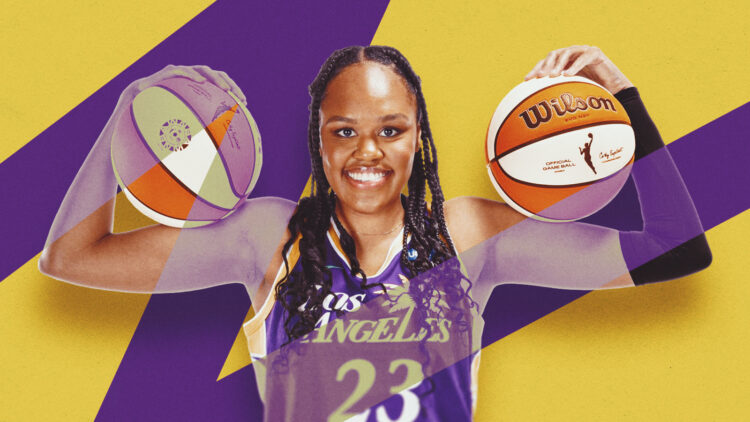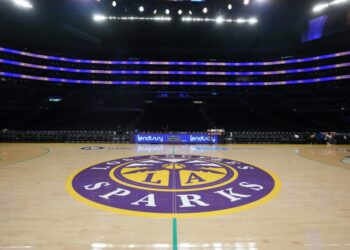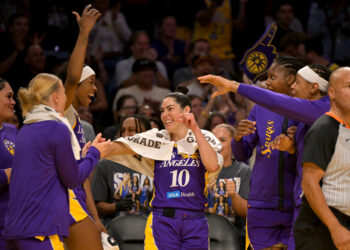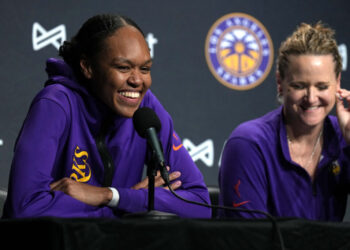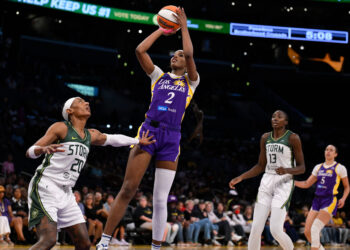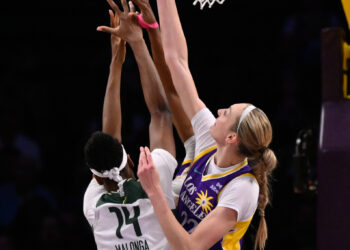With two lottery picks and a youth-driven roster in the building, a fresh movement has fully hit the Los Angeles Sparks.
The Sparks will look completely different this season after Nneka Ogwumike signed with the Seattle Storm and lead guard Jordin Canada was traded to the Atlanta Dream for Aari McDonald and a pick swap.
However, roster mainstay Azurá Stevens is primed for success as a leader for the team, entering just her second season in LA. Veteran presence is critical for young and new-look rosters. While Stevens may still be relatively new to the Sparks, she is equipped to step into that veteran role, considering that she is now entering her seventh season in the WNBA and has a championship season under her belt with the Sky in 2021.
Unfortunately, though, her on-court season will have a delayed start. At the end of March, the Sparks announced that Stevens underwent successful surgery after injuring her left arm playing in China during the offseason. When the team announced their training camp roster, they noted she will be re-evaluated in eight weeks, which puts her timeline to return toward mid- to late-June.
But that doesn’t mean she won’t make an impact on this year’s iteration of the purple and gold.
The Sparks brought in exciting, new faces to help drive the franchise forward as they work to build a contender. Stevens can be a constant through it all, especially for Cameron Brink. The second overall pick in the WNBA draft can learn a lot from Stevens as both players live in the post. There’s also the fourth pick, Rickea Jackson, who’s a great rebounding forward in her own right, in addition to everything she can do as a scorer.
Head coach Curt Miller highlights defense, taking pride in the fact that the Sparks were the best defensive team in the league analytically after the All-Star break last year. Stevens played a big role in that, averaging 2.1 stocks (steals plus blocks) throughout the entire season.
The 6’6” big shines as a rim protector, but she can’t do it all on her own. Last year, LA was near the bottom of the league in both rebounding and rim protection numbers. A priority to improve at the rim defensively helped confirm that Brink was the right pick for the Sparks with the second overall selection. She was the best shot blocker in the country, averaging 3.7 blocks per game (BPG) during her senior season at Stanford while also averaging 11.8 rebounds per game (RPG), which was fifth-best across all NCAA Division I teams. Working in the paint isn’t the same at the college level compared to the WNBA, though. Players need the time to adjust to the physicality and play styles at the professional ranks. Stevens succeeded in the post for the Sparks last year and is in position to do even more in year two with the team, both on the court upon her return as well as in the locker room as a leader.
On the court, Stevens is versatile, playing at the four at times last season. Her long frame and athleticism makes two-big lineups feasible, meaning she can play alongside Dearica Hamby or Brink in the frontcourt this year.
Stevens spaces the floor with her outside shooting ability, connecting on 32.1 percent of her 3.1 three-point attempts (3PA) per game last year. She shot 36.2 percent from deep on 3.3 3PA per game the season before, which was her last with the Chicago Sky.
Brink shot threes at an increased volume during her senior year. The outside shot is presumably an area of growth for her as she begins her WNBA career. Stevens is the perfect person to help with that as someone who’s shown growth and developed consistency as a three-point shooter over time.
In addition to helping the Sparks’ youth get their footing, Stevens will also play a critical role in helping to fill the void left by the departures of Nneka Ogwumike and Canada. Nneka Ogwumike and Canada led LA last season in terms of shot volume, averaging 14.3 and 10.6 field goal attempts (FGA). Stevens was just behind with 10.5 FGA per game. Last year, Stevens averaged 10.8 points per game (PPG) and 5.9 RPG playing alongside Nneka Ogwumike in the frontcourt. With no Nneka or Canada, about 25 shots per game are unaccounted for. Stevens is the strongest candidate to absorb a large chunk of that volume once she’s back healthy and ready to play.
Of course, LA’s offensive workload won’t be all on Stevens once she returns. Hamby is still around to team up with in the post. Kia Nurse was traded from Seattle to LA along with the fourth overall pick in this year’s draft (which the Sparks used to select Jackson) in exchange for future draft capital. Lexie Brown played great in just 12 games last year, missing a majority of the season, and is back with the Sparks.
This year is LA’s first without Nneka Ogwumike in 12 seasons. Through that time, she won the Rookie of the Year award, made eight All-Star games, and won an MVP and the WNBA championship in 2016. The franchise has gone through considerable change since that most recent championship, of course, but some form of consistency is important when you lose a player like Nneka.
Stevens offers just that. She had a fantastic first year with LA, excelling in multiple roles and putting up strong numbers in the process. She fought through injury, too, missing the first five games in 2023 due to a back injury. Year two will be delayed on the floor for her as well, but in the meantime, she provides invaluable experience and leadership that will help LA’s young team.
Then, once she’s back on the court, it’s only up from there.
Unless otherwise noted, all stats courtesy of WNBA.com and Her Hoop Stats.
